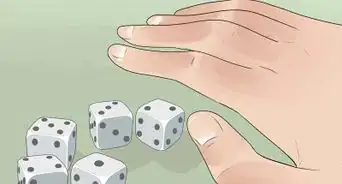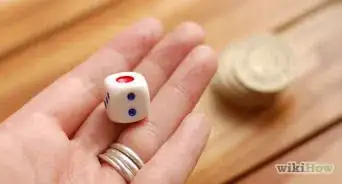X
This article was co-authored by wikiHow Staff. Our trained team of editors and researchers validate articles for accuracy and comprehensiveness. wikiHow's Content Management Team carefully monitors the work from our editorial staff to ensure that each article is backed by trusted research and meets our high quality standards.
This article has been viewed 47,509 times.
Learn more...
Dice games are highly portable and can be played nearly anywhere. One simple dice game you might enjoy with your friends is called Lucky Numbers, though you may be more familiar this game by the name of Lucky Dice. You can play with as few as two people, as long as you have at least one die to play with.
Steps
Part 1
Part 1 of 3:
Agreeing on the Rules
-
1Determine the rounds and throws per play. A throw is a single toss of the dice.[1] You might decide to play three rounds with each round being made up of a single throw, or you may want to have several throws per round. The number or rounds and throws per round is a matter of preference.
- Adding more throws per round can add uncertainty to your game. This will likely make it more exciting.
-
2Agree on scoring. There are many ways you might score your game of Lucky Numbers. You could award points per throw, per round, or for both. When giving points for both throws and rounds, you may want to weight the points scored by round winners as an added bonus.
- Awarding bonus points for round winners can be especially fun with many players. As there will be more players, the points will be more spread between players. This will make winning rounds more important.
Advertisement -
3Decide on when lucky numbers will be chosen. Points are given to players who chose the number that is rolled by the dice. For a faster paced, more exciting game, you may want to choose your lucky number at the beginning of each throw. More laid back games can be played by selecting a lucky number for a whole round.
- You can add variation to your game by having each player choose more than one lucky number. This works especially well when rolling multiple dice, as the spread of the numbers rolled will be wider and another lucky number will improve your odds.
Advertisement
Part 2
Part 2 of 3:
Playing the Game
-
1Gather some dice and players. This game can be played with one, two, three, or four dice. You can play this game with as few as two people and there is no upper limit on the number of players. Every time you add a die to your game of Lucky Numbers, the probability of your number coming up will become lower, increasing the game's difficulty.
-
2Select your lucky number. The easiest way to play Lucky Numbers is to have each player select a number before the dice are rolled. If you are playing with many players, you may want to note down everyone's chosen number to keep players honest.
- It's perfectly alright to choose the same number when playing Lucky Numbers. This is a game of intuition, so you should follow your gut. However, players that choose the same number will always finish a throw in a tie.
- You may want to institute a tiebreaker to establish the point winner when there is a tie. For example, you might have tied players have a "roll off," where each player rolls a die and the highest number takes the point. In the event of another tie, roll again.
-
3Take turns throwing the dice. Pass the dice around between players and roll the dice for the number of throws you have decided per round. Continue to do this until you have played the determined number of rounds. You'll want to keep a tally of each player's lucky number throws for score keeping.
- To determine the first roller of the dice, you might play a game of rock, paper, scissors, with the winner taking the first throw. You could also have a roll off, where each player rolls a die and the highest number starts the game. Ties in a roll off can be settled with by re-rolling until a player wins.
-
4Count your points and declare the winner. The winner of Lucky Numbers will be the person who has the most points. This will likely be the person with the most lucky numbers guessed, though depending on how you've chosen to score your game, this may not always the case.
Advertisement
Part 3
Part 3 of 3:
Adding Variations
-
1Add a low, mid, high bet. You can divide the span of numbers possible to roll with your dice into low, mid, and high categories. For example, with two dice, you might decide that a low bet will cover 2 - 5 (you can't roll a 1 with two dice), a mid bet 6 - 8, and a high bet 9 - 12. Since there is a better chance of a throw landing in these spans, you may want to award less points for these bets.[2]
- A weighted point system will create more varied strategy while playing and will allow underdogs a chance of coming back. For example, in the last throw of a round, one player might have 5 points and another 3. If a low, mid, high bet is only worth ½ a point, but a single number bet is worth 3 points, the lower point player will have a chance to win with a single number bet.
-
2Allow odd and even bets. Similar to low, mid, high bets, odd or even bets have a higher probability of happening. The odds of rolling an odd or an even will be even higher than a low, mid, or high bet. This being the case, you may want to award less points for these.
- If playing with both low, mid, high bets and odd and even bets, you might arrange the point values to reflect the probability of these rolls. For example, you might have odd and evens worth the least amount of points, then low, mid, high bets, then single number bets.
-
3Reward doubles bets. This will only be possible when rolling two or more dice. With two dice, the chance of rolling doubles is 1/6, or 16.66%. The chance of rolling a single number with two dice is 1/11, or 9.09%. To keep the game fair, your scoring should reflect this difference in probability.
- You'll have to take into account the fact that adding more dice to your throws will increase the probability of rolling doubles. There is a 41.66% chance of rolling doubles with three dice. With four dice, the chance of doubles is 55.55%.[3]
Advertisement
Things You'll Need
- Dice, 1-4
- 2 or more players
- Clear space to play on
- Notepad and pen to keep score
References
About This Article
Advertisement
-Step-1-Version-2.webp)
-Step-2-Version-2.webp)
-Step-3-Version-2.webp)
-Step-4-Version-2.webp)
-Step-5-Version-2.webp)
-Step-6.webp)
-Step-7.webp)
-Step-8.webp)
-Step-9.webp)
-Step-10.webp)


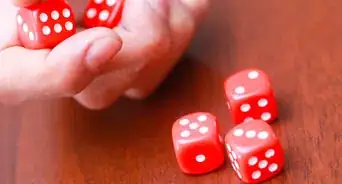
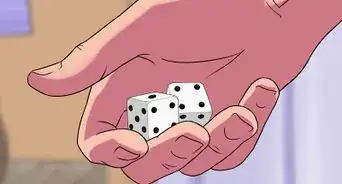

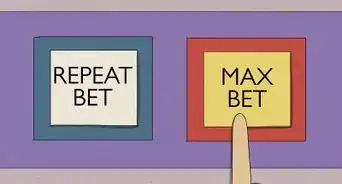
-Step-35.webp)

